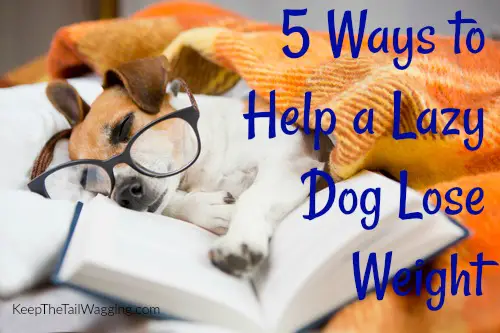Keep the Tail Wagging is supported by pet parents. I occasionally earn a commission (at no additional cost to you) when you click through an affiliate link to one of my favorite products. Thank you for your support. Read More
Years ago, one of our dogs was fat, and I took some flack on social media. It was brutal. But, to be honest, they weren’t wrong. My dog needed to lose weight, but she was my couch potato, she was living with a partial cruciate tear and arthritis, and no matter how much I decreased her meals, she wasn’t losing weight. After a lot of research, chatting with other raw feeders, and working with her veterinarian, Sydney lost twenty pounds – dropping from 85 to 65 pounds.
Health Risks of Overweight Dogs
Overweight and obese dogs have an increased risk of:
- several types of cancer
- diabetes
- heart disease
- liver disease
- kidney disease
- hypertension
- arthritis
- urinary bladder stones
- anesthetic complications
- less heat tolerance
- decreased lifespan
5 Ways to Help a Lazy Dog Lose Weight
After having Sydney’s thyroid tested a couple of times, it was clear that her weight issue was due to lifestyle and diet. The following are steps that I took to help Sydney lose weight.
1 – Respect My Dog’s Comfort Zone
I made a mistake trying to get Sydney to walk like our other dogs. Due to her arthritis and injury, she couldn’t go on long walks. We live on five acres, and our neighbor created a walking trail on his property that he allows us to use. Because Sydney was more comfortable at home, we began walking around the yard daily. We started with 15-minute walks and eventually worked our way up to walking around our property several times.
2 – Don’t Push My Dog Past Her Limits
I was able to extend our walks because I didn’t push Sydney. She’d sit down when she was finished walking, and we’d return to the house. By slowly increasing her endurance, I could decrease how often she needed pain medication and prevent further injury. A year after we started walking, she would go on short (1/2 mile) runs with me.
3 – Staying Engaged on Our Walk
I love listening to podcasts and Audible books while walking the dogs. But I found she had more fun by leaving my phone in the house and focusing 100% on my dog. The podcasts/books created a distance, and Sydney appeared to be less engaged in our walks. When I’d walk with her, sharing details of my day, she seemed happier and walked with me for longer.
4 – Make the Walks Fun
Sydney was such a silly girl, and it showed when she was having fun. She’d roll down hills, headbutt me in the legs, and then run ahead only to come right back. I let her decide where we’d go to keep our walks fun. Sometimes, we’d do laps around the property and walk the neighbor’s trails. It was so much fun waiting to see what she wanted to do each day.
5 – Allow Her to Have a “Rest” Day
I learned that it’s important to have rest days. Living with multiple dogs means walking and playing daily, so I appreciated those rest days too. Sometimes she’d stay in the house while I took the other dogs outside. Other times, she’d join us outside and relax in the shade. The rest days gave her muscles and joints time to relax, preventing further injury.
Adjusting My Dog’s Diet
Because Sydney needed to lose weight, I decided not to use training treats to encourage her to walk. I know that I could have reduced her meals, but I didn’t want to take a chance of derailing her progress at the time.
I reduced her meals by two ounces, replacing the food I took away with green beans or my vegetable mix. I went for low-glycemic vegetables and avoided starches.
Fasting My Dogs
And after a few months, I began fasting my dogs once a week. It was a modified fast because Sydney had a history of hunger pukes. I fed the dogs raw goat’s milk or bone broth on fasting days instead of their regular raw meals. This served to give her gut a break, which also helped her reach a healthy weight.
Keto Diet for Dogs
A benefit of feeding a keto diet is weight loss. However, if done incorrectly, it could lead to weight gain. I wasn’t familiar enough with feeding a keto diet and didn’t want to risk making a mistake, so I stuck with raw feeding, which is high in protein and low in carbs. I add fat to my dogs’ diet (salmon oil, raw goat’s milk, kefir, MCT oil), but not enough to push my dogs into ketosis.
